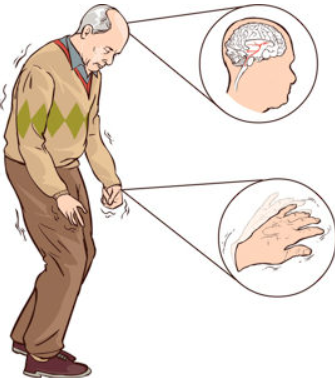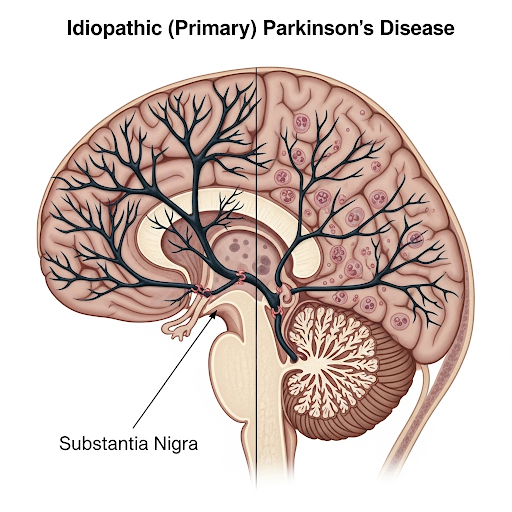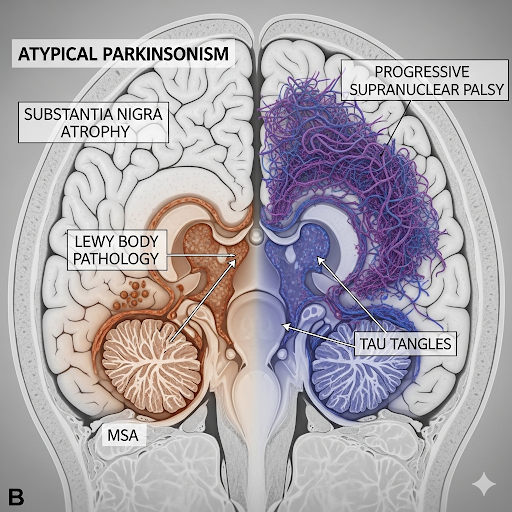Parkinson’s malady is a neurological malady that progresses and affects the movement, caused by the destruction of neurons that produce dopamine in the service. Typical symptoms include trembles, motion movements (bradykinesia), musculature (hypertonia), and postural installation. It can’t be repaired, treatments and treatments can help improve the symptoms and improve the quality of life.

The causes of Parkinson’s
1. Genetic Factors
Certain gene mutations increase the risk of developing Parkinson’s, though most cases are sporadic (not inherited). Key genetic contributors include:
- SNCA gene – produces alpha-synuclein protein; abnormal aggregation forms Lewy bodies.
- LRRK2 gene – mutations can cause late-onset PD.
- PARK2 (parkin), PINK1, DJ-1 genes – linked to early-onset Parkinson’s.
Only a small fraction (~10–15%) of PD cases are directly caused by genetic mutations.
2. Environmental Factors
Exposure to certain environmental toxins and lifestyle factors may increase PD risk:
- Pesticides and herbicides (e.g., paraquat, rotenone).
- Heavy metals (e.g., manganese, lead).
- Rural living and well water (possibly due to pesticide exposure).
- Head trauma – repeated concussions may slightly increase risk.
Some protective factors have also been observed, like caffeine intake and smoking (though not recommended as preventive measures due to other health risks).
3. Biological Mechanisms
Parkinson’s is characterized by the loss of dopamine-producing neurons in the substantia nigra of the brain. Contributing mechanisms include:
- Alpha-synuclein aggregation → formation of Lewy bodies that disrupt neuronal function.
- Mitochondrial dysfunction → impaired energy production in neurons.
- Oxidative stress → damage from reactive oxygen species.
- Neuroinflammation → chronic inflammation may contribute to neuron death.
4. Age
Age is the single biggest risk factor. Most people develop Parkinson’s after age 60, though early-onset PD can occur.
5. Other Possible Factors
- Sex: Men are slightly more likely to develop PD than women.
- Gut microbiome: Emerging research suggests gut health may influence neurodegeneration through the “gut-brain axis.”

Types of Parkinson’s:
1. Idiopathic (Primary) Parkinson’s Disease
- Most common type (~85–90% of cases).
- Cause is unknown, though likely due to a mix of genetics and environment.
- Characterized by classic motor symptoms: tremor, rigidity, bradykinesia (slowness), postural instability.
- Often includes non-motor symptoms: depression, sleep problems, autonomic dysfunction.

2. Secondary (Atypical) Parkinsonism:
Caused by an identifiable factor rather than idiopathic degeneration. Includes:
- Drug-induced Parkinsonism: caused by medications like antipsychotics or anti-nausea drugs.
- Vascular Parkinsonism: due to strokes or reduced blood flow in the brain.
- Toxin-induced Parkinsonism: exposure to pesticides, heavy metals, or certain chemicals.
- Usually symptoms may improve if the cause is removed (e.g., stopping the drug).

3. Hereditary or Genetic Parkinson’s
- Linked to specific gene mutations (SNCA, LRRK2, PARK2, PINK1, DJ-1).
- Can cause early-onset PD, sometimes before age 50.
- Often has slower progression than idiopathic PD.
4. Atypical Parkinsonian Syndromes (Parkinson-plus Syndromes)
These mimic Parkinson’s symptoms but progress differently and usually respond poorly to standard PD medications:
- Multiple System Atrophy (MSA): affects autonomic functions (blood pressure, bladder) along with movement.
- Progressive Supranuclear Palsy (PSP): causes balance problems, vertical gaze difficulty, and stiffness.
- Corticobasal Degeneration (CBD): asymmetric stiffness, tremor, and cortical dysfunction like apraxia.
- Lewy Body Dementia (LBD): cognitive decline appears early, along with Parkinsonian motor symptoms.
5. Juvenile or Early-Onset Parkinson’s
- Appears before age 50, sometimes in teens or 20s.
- Often linked to genetic mutations.
- Symptoms are similar but progression may be slower.
Parkinson’s disease symptoms:
1. Motor Symptoms (Most Recognizable)
- Tremor
- Usually occurs at rest (“resting tremor”).
- Often starts in one hand or finger.
- May disappear during voluntary movement.
- Muscle Rigidity
- Stiffness in arms, legs, or trunk.
- Reduces range of motion and may cause pain.
- Bradykinesia (Slowness of Movement)
- Movements become slower and smaller.
- Difficulty starting or stopping actions.
- Postural Instability
- Loss of balance and increased risk of falls.
- Usually appears in later stages.
- Other Motor Signs
- Shuffling gait, small steps.
- Reduced facial expression (“mask face”).
- Micrographia: handwriting becomes small and cramped.
2. Non-Motor Symptoms
- Sleep Disturbances
- Insomnia, restless sleep, vivid dreams or nightmares.
- Cognitive and Emotional Issues
- Depression, anxiety, apathy.
- Cognitive decline that can progress to dementia.
- Autonomic Dysfunction
- Orthostatic hypotension (blood pressure drops when standing).
- Constipation, urinary problems.
- Excessive sweating.
- Sensory Symptoms
- Loss of smell (anosmia).
- Muscle pain or tingling sensations.
- Fatigue and Weakness
- Persistent tiredness even after rest.
Parkinson’s disease treatment:
1. Medications
Medications aim to replace or mimic dopamine in the brain or manage specific symptoms.
a. Dopaminergic Medications
- Levodopa + Carbidopa
- Gold standard treatment.
- Converts into dopamine in the brain.
- Reduces tremor, rigidity, and bradykinesia.
- Long-term use may cause “on-off” fluctuations or dyskinesias (involuntary movements).
- Dopamine Agonists (e.g., pramipexole, ropinirole)
- Mimic dopamine effects in the brain.
- Can be used alone (early disease) or with levodopa.
- Side effects: sleepiness, hallucinations, compulsive behaviors.
- MAO-B Inhibitors (e.g., selegiline, rasagiline)
- Prevent dopamine breakdown.
- Mild symptom relief, often used in early stages.
- COMT Inhibitors (e.g., entacapone)
- Extend the effect of levodopa.
b. Other Medications
- Anticholinergics: help control tremor, especially in younger patients.
- Amantadine: can reduce dyskinesias and mild symptoms.
- Medications for non-motor symptoms: antidepressants, sleep aids, or drugs for constipation and blood pressure issues.
2. Physical and Occupational Therapy
- Physical therapy: improves mobility, balance, flexibility, and posture.
- Occupational therapy: helps maintain independence in daily activities.
- Speech therapy: treats speech and swallowing difficulties (dysarthria, dysphagia).
- Exercise: aerobic, resistance, and balance training slow symptom progression and improve quality of life.
3. Surgical Treatments
Deep Brain Stimulation (DBS)
- Electrodes implanted in brain areas (usually subthalamic nucleus or globus pallidus) connected to a pacemaker-like device.
- Reduces tremor, rigidity, and “on-off” fluctuations.
- Does not cure PD but improves symptom control.
Other Surgical Approaches
- Rarely, lesioning procedures (pallidotomy, thalamotomy) are used in select cases.
4. Lifestyle and Supportive Measures
- Healthy diet, good sleep, and regular exercise improve overall well-being.
- Counseling or support groups help cope with emotional challenges.
- Regular follow-up with a neurologist specialized in movement disorders.
I was diagnosed with Parkinson’s disease four years ago. For over two years, I relied on Levodopa and several other medications, but unfortunately, the symptoms kept getting worse. The tremors became more noticeable, and my balance and mobility started to decline quickly. Last year, out of desperation and hope, I decided to try an herbal treatment program from NaturePath Herbal Clinic. Honestly, I was skeptical at first, but within a few months of starting the treatment, I began to notice real changes. My movements became smoother, the tremors subsided, and I felt steadier on my feet. Incredibly, I also regained much of my energy and confidence. It’s been a life-changing experience I feel more like myself again, better than I’ve felt in years.If you or a loved one is struggling with Parkinson’s disease, I truly recommend looking into their natural approach. You can visit their website at www. naturepathherbalclinic. com